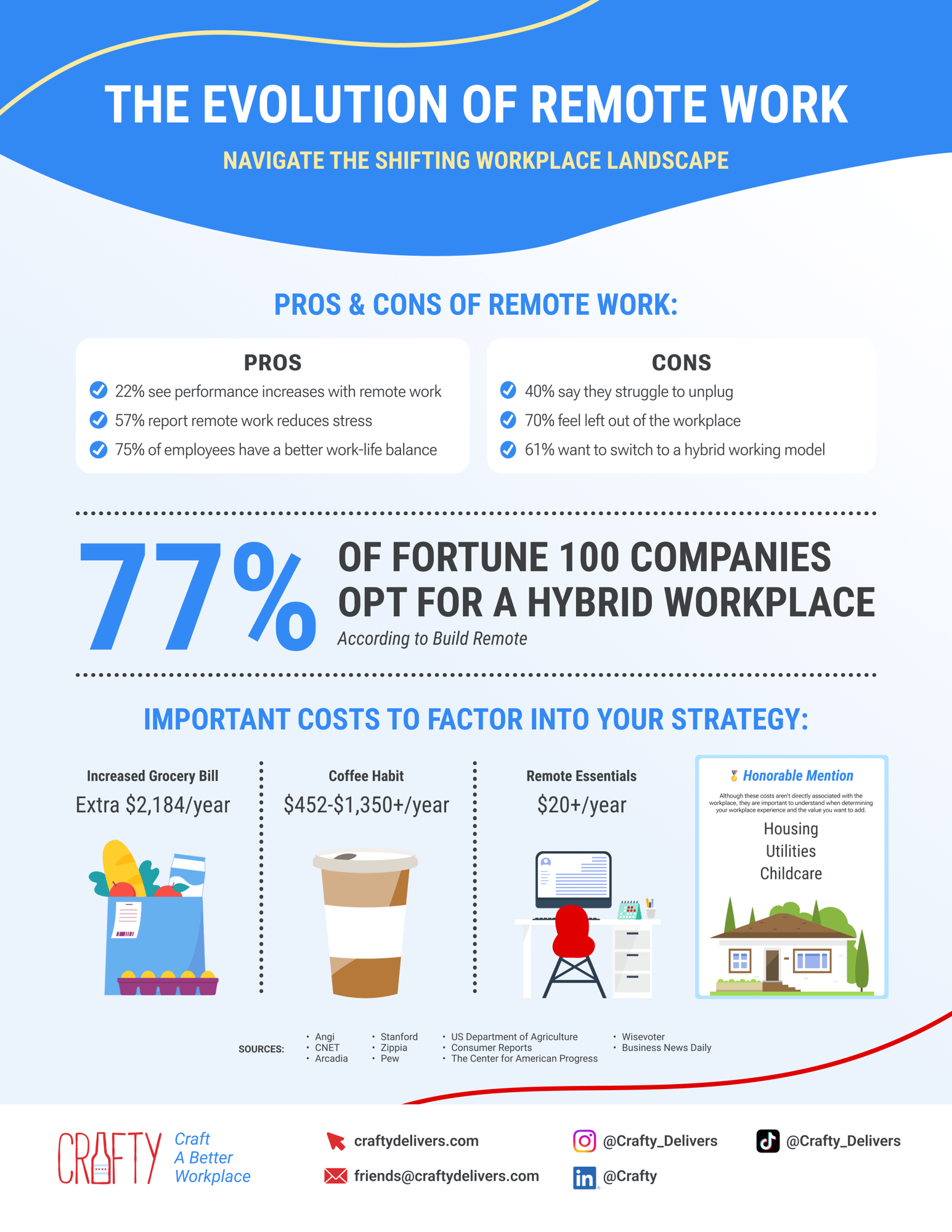The Evolution of Remote Work
In recent years, the office experience has undergone a monumental transformation. Fueled by the rapid advancement of digital technologies and catalyzed by the global pandemic, an unprecedented wave of individuals transitioned to remote work, reshaping the professional landscape as we know it.
As the world came out of the pandemic, companies had difficulty landing on a new workplace strategy. In 2021 and 2022, companies mandating in-office attendance were met with significant levels of resistance and backlash, resulting in "The Great Resignation" of their workforce. On the other hand, you saw companies switching to 100% remote, impacting surrounding local businesses, company culture, and employee retention rates.
Hybrid offers a compromise, with 77% of Fortune 100 companies opting for this model. Employees can enjoy the flexibility of remote work to focus on deep work while they use office days to foster connections and innovation. As the iconic theme song of a beloved Disney Channel show once said, "You mix it all together and you know that it's the best of both worlds."
We broke down the advantages of an office experience plus the cost of returning to the office in 2023. Now, it's time to present the other side of the coin. Companies and employees must fully understand the benefits and costs of remote work to craft a more balanced workplace strategy. This understanding can fuel a consistent, thoughtful and impactful employee experience in this new hybrid era.
Here’s what we’ll be breaking down:
2025 WORKPLACE TRENDS REPORT
7 PREDICTIONS TO FUTURE-PROOF YOUR WORKPLACE
Discover seven research-backed predictions and actionable strategies to transform your workplace into a connection catalyst that drives meaningful results.
Pros & Cons of Remote Work
Before we jump into the numbers, let’s recap the pros and cons of remote work.
Pros of Working At Home:
The impact of remote work on employees is layered, with both positive and challenging consequences. On the one hand, the flexibility to work from home can improve productivity and work-life balance while removing the stress of commuting and other costs associated with going to the office.
- 22% of employees see an increase in performance when they work at home [Stanford]
- 57% of employees see a stress reduction when they work remotely [Zippia]
- 75% of employees have a better work-life balance [Business News Daily]
Cons of Working At Home:
On the other hand, this physical separation can lead to feelings of isolation, resulting in less collaboration and engagement in an organization. Remote work blurs the boundaries between work and personal life, contributing to burnout.
The Key to Implementing a Successful Hybrid Experience
As you can see, the data behind remote work is mixed and sometimes even contradictory. Employees may demand flexibility yet are more likely to burnout because they need help to unplug, leading to increased turnover. We don't have to put employees in a corner.
Hybrid is the ideal solution that provides the flexible environments employees are looking for. That said, the hybrid framework needs elements in place to work both in the office and at home:
- You have to have team buy-in and office traffic coordination to realize the office experience's true benefits. How does an empty office promote employee engagement and collaboration? How does scheduling all your meetings on remote days promote space for strategic thinking? Spoiler alert: it doesn't.
- You have to understand the daily habits of your employees and deliver a holistic benefits package that provides value financially and mentally. The office needs to have amenities that make the commute worth it, while remote employees should have the infrastructure to make their home environment a productive place to work.
Now is the best time to uncover your remote employees' daily routine with associated costs to spot the opportunities where you can deliver more value as their employer. 🕵️

Increased Grocery Bill: Additional $2,184/year
Remote work allows employees to save big by avoiding commute costs, but some of these gains are repurposed toward extra groceries. According to a recent study, remote workers are more likely to spend $182 more on groceries than their in-office counterparts as they prep more food at home and stock up on their favorite workday snacks, drinks, coffee and more.
The average US consumer spends 11.3% of their disposable income on food. Suppose we use that percentage on the average US wage of $52,654/year; that would mean employees' food costs are around $5,950/year and $495/month. When we zoom in on the food costs within the workday, here's the difference between making food at home versus going out to eat based on our research:
- Breakfast:
- Making Food At Home: $109/month
- Going Out to Eat: $120/month
- Lunch:
- Making Food At Home: $109/month
- Going Out to Eat: $300/month
- Snacks: $37/month
- Drinks: $40/month
There are some significant savings to be had for remote workers when it comes to meals made at home. During the pandemic, most of us prepped our meals at home, but as the world opened up and people started to go back to the office, food consumption has increased away from home, according to the US Department of Agriculture. Honestly, we were probably all sick of doing dishes. 😉
US Department of Agriculture
The big opportunity for top workplaces is the daily office snack and drink costs. If employees aren't spending their hard-earned paycheck on daily essentials to get them through the day, they can use that money in areas to have a better work-life balance. Simply having an office snack station or snack box perks can save employees $77/month and $924/year. Add in some corporate catering options and that number increases even more.
On top of the financial benefits, food makes employees feel healthier and happier while improving productivity both in the office and at home. All these are crucial for employee acquisition and retention, with 61% of employees changing jobs because of food benefits. As it takes 3-4x a position's salary to acquire new talent, companies have a lot to gain by enacting thoughtful office food programs tailored to employee preferences.
Coffee: $452-$1,350+/year
Coffee costs alone show how even the smallest of rituals can add up. According to a recent Drive Research study, 74% of people drink coffee daily and employees across the US need their morning coffee to be their most productive selves at work.
Of course, we would NEVER suggest dropping your coffee habit – not only is that off-brand, but it's unrealistic. It's just something to be mindful of when crafting your workplace strategy. Whether making your coffee at home or buying from a coffee shop, your coffee isn't free.
The avid coffee drinker can spend anywhere from $452-$1,350+/year on coffee, depending on where they get their caffeine fix. 🫠 We used CNET to break it down even further.
If you make your coffee at home…
- Black Coffee: $1.24/coffee
- Coffee + Milk: $1.35/coffee
If you decide to hit the local coffee shop…
- 12oz Drip Coffee: $1.85+/coffee (and that's at the very low end of the spectrum)
- 16oz Latté or Specialty Drink: $3.65+/coffee
- 20oz Latté or Specialty Drink: $4.75+/coffee
This is why office coffee services are a staple in workplace culture, regardless of the setting. According to a recent Swinburne University of Technology study, half of remote workers spend a significant portion of their workday at coffee shops, which can quickly add up. Crafty provides $35/month for employee snack boxes and coffee lovers use those credits to purchase coffee beans, cold brew cans and other coffee essentials.
Innovative, hybrid workplaces put a huge focus on building out robust office coffee stations as an incentive to work in the office. In 2023, Crafty saw the office coffee category spending grow by 64% compared to the previous year, while Gensler reported that Gen Z, Millennials and Gen X prefer an office coffee shop vibe within their ideal work experience.
Coffee is personal, meaning the offering needs to provide a customized experience that is tailored to employee needs. Companies are often outfitting their office coffee service with essentials to provide that personalized experience ranging from top-tier corporate coffee machines, locally sourced beans, cold brew kegs, or packaged special drinks. Some even go as far as creating in-office cafés with baristas to whip up employee favorites.
Work From Home Essentials: $20+/year
Working on the bed, couch, or kitchen table may work for a few employees, but more often than not, many opt for building out some sort of home-office setup. This could range from a simple desk in the corner to a full room with the works.
According to Angi, creating a home office can cost anywhere from $20 to over $5,000:
- Lighting: $20+
- Furniture: $100+
- Storage: $150+
- Office Supplies: $50+
Based on a Forbes report listing the top remote jobs, the roles most likely to come with remote perks are often data-focused. An accountant was the most common remote job posting in 2022, followed by Executive Assistant, Customer Service Representative and Senior Financial Analyst. These positions typically require more technical supplies like additional monitors, keyboards, printers and more which can add up quickly.
That said, decked-out home offices aren't exclusive to those specific jobs or remote-only employees. In hybrid environments in 2023, offices are being transformed to offer a variety of multi-use areas like office kitchens and pantries, cafés, lounge areas and more. Of course, there are still individual work areas, but much of that is open-concept to encourage casual brainstorming and spark creativity.
Hybrid employees use their work-at-home days to focus on the execution of the conversations had within the office. Their home office is the hideaway to concentrate on projects without distractions, requiring technical supplies and fuel to boost productivity.
Innovative companies, fueled by Crafty, rise to the challenge by providing employee snack boxes and remote work essentials to make flexible remote days more impactful. Every person requires a different cocktail of snacks, drinks and coffee to fuel their day and personalized options chosen by the employee are essential to a successful program.
Honorable Mentions
The difficult part about determining the costs around remote work is separating what it costs to work versus what it costs to simply live. When employees work at an office, there are specific things that are paid for by the company outside of just the building: electricity, water, WiFi and, if you're lucky, coffee, snacks, drinks and beyond.
Spending 50% of your waking hours working in your own home increases the cost of living across a few areas. We're going to dive into the details of where those increases are happening. Keep in mind that some of these aren't due to remote work but simply a reality of living in today's inflated world.
Employees will always have costs regardless of where and how they work. Just remember, the goal is to fully understand the costs your employees face throughout the workday to craft better programming to attract and retain them.
Housing: $2,054/month
Housing is a cost that has long burdened employees. Since the pandemic, the National Bureau of Economic Research reported, "the shift to remote work explains over one-half of the 23.8% national house price increase." The study also points out that 40% of US renters pay more than 30% of their net income for housing, while Entrepreneur states that the average employee is searching for larger apartments costing 20% more in rent.
Our friends at NerdWallet shared that the average rent in the US as of July 2023 is $2,054/month, a 4.1% increase over last year. "As the pandemic increased the popularity of remote work, renters sought larger homes in areas that had been previously relatively low-cost," says NerdWallet. "This migration increased rents in suburban areas more than it lowered them in urban ones, yielding a net increase in rents."
This higher investment in home living makes future workplace programming even more important. Hybrid workers need a holistic approach to workplace programming to foster work-life balance from the home to the office. Flexible benefits, alongside crafting an accepting culture, keep employees from burning out. Then streamlining office traffic utilizing tools like food and beverage can foster more socialization that snowballs into more effective communication.
Extra Utility Expenses: Additional $1,452/year
In addition to rent or mortgages, utilities are another area that saw significant cost increases. The National Bureau of Economic Research reported a $40-$50/month increase in energy costs among remote employees during the pandemic. It doesn't take a rocket scientist to figure out that you use more of everything when you spend more time at home. 🫣
A study during the pandemic found that those who work at home spent an additional $121 more on utilities each month. The average person will spend the following on utilities regardless of where they work:
- Energy: $100/month [Arcadia]
- Water: $54/month [Wise Voter]
- Internet: $74.99/month [Consumer Reports]
- Utilities Total: $228.99+/month
Although utilities have leveled out since the pandemic, these costs are still important to remember when developing your employee perks. Many top workplaces provide work-from-home stipends designed to cover phone, internet and more to offset these costs and we expect that trend to continue alongside offsetting other costs like food and beverage.
Childcare: $13,000-$30,000/year
Many think you can save on childcare expenses when you work from home. In some cases, this is true and during the pandemic, many parents opted to keep their kids completely, saving some serious money. However, this is not the case for everyone.
It's reported that 58% of working parents rely on childcare centers in 2023, which isn't shocking. According to Zippia, "22% of all parents with young children say that they cannot work, either in person or remotely, without childcare." The perks of a hybrid or flexible schedule are working from home when your kid is sick, going to school during working hours for programming, or commuting shorter distances to pick up your kid.
Have you ever tried to work at home with a toddler? It's next to impossible, but the alternative isn't cheap. Parents are spending between $1,300 and $2,500 per month on childcare, so saving them $10 to $20 per day can be a lot in the long run. In a survey conducted by NPR, over 50% of parents acknowledged that childcare expenses posed a somewhat serious challenge, with an additional 20% deeming it a serious concern.
As companies design the workplace of the future, understanding the costs working parents face can help design long-term employment retention strategies. You want to grow with your employees and for those who have children, anything to offset the costs outside of their workday is valued. In a parent's mind, even a $10/week savings on office snacks can be used to pay for an extracurricular class or sport.
Conclusion
The shift towards remote work in 2023 has brought both opportunities and challenges. Hybrid work is the ideal compromise that provides remote flexibility alongside in-office collaboration. For it to work effectively, it has to be pulled off thoughtfully, factoring in a holistic view of the daily essentials your employees need.
Recognizing the financial impact of flexible work allows organizations to craft better office experiences that create stronger cultures in and out of the office. This results in increased employee engagement and loyalty while fostering a long-term employee retention strategy.
There are many facets to consider, some of which are the cost of living as a whole, but F&B solutions are an easy way for enterprise companies to scale a program that makes a regular impact on employees. Food and beverages are essential to everyone's daily life and enrich employees' lives financially, socially and mentally.
Learn more about how Crafty can elevate your workplace experience for the new hybrid era.
Snack on More Insights
CRAFT
A BETTER
WORKPLACE
Elevate your office food and beverage program with enhanced services managed in one innovative, centralized platform.




.webp?width=2000&height=1000&name=Is%20Your%20Office%20Pantry%20Giving%20ROI_%20(1).webp)